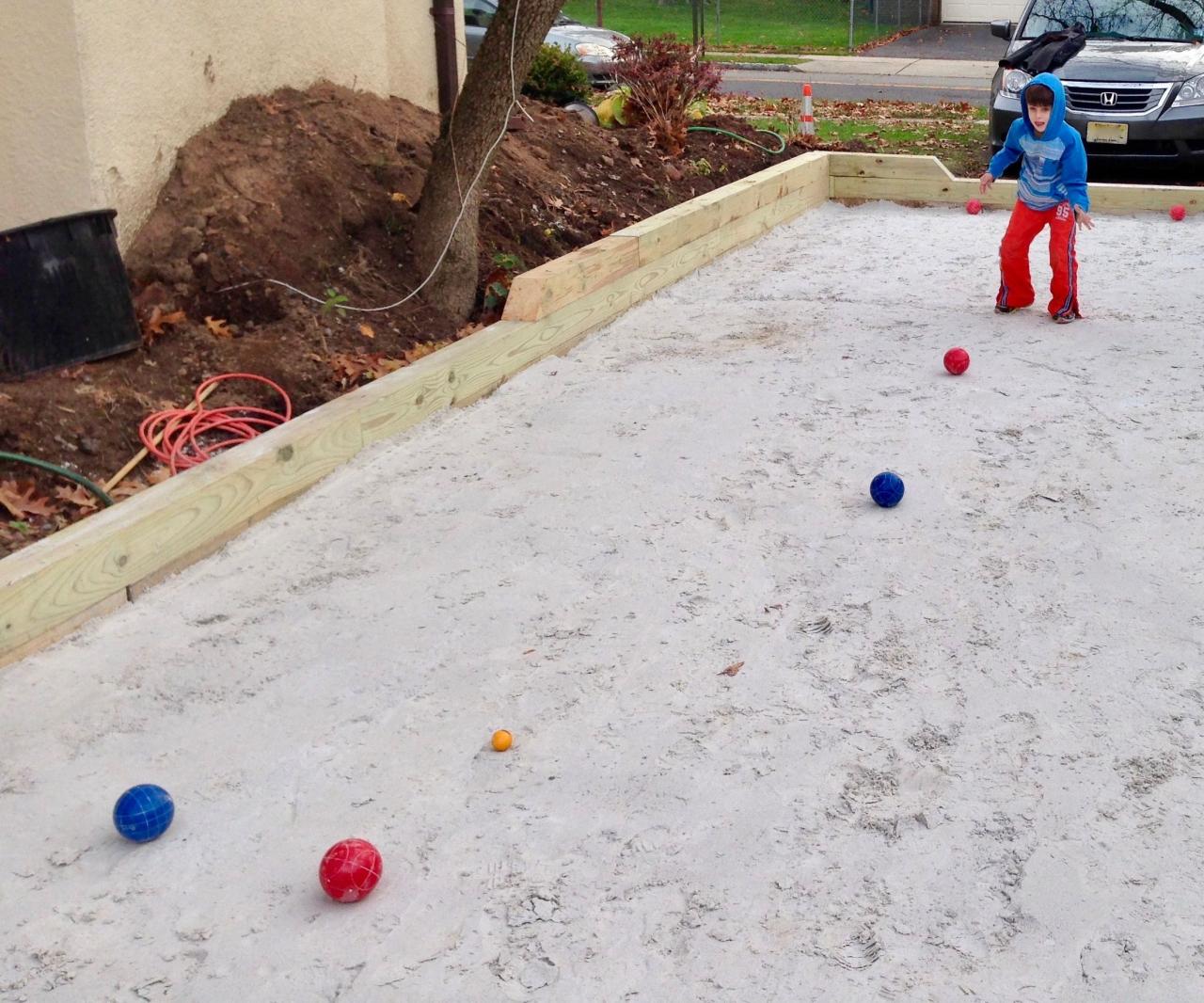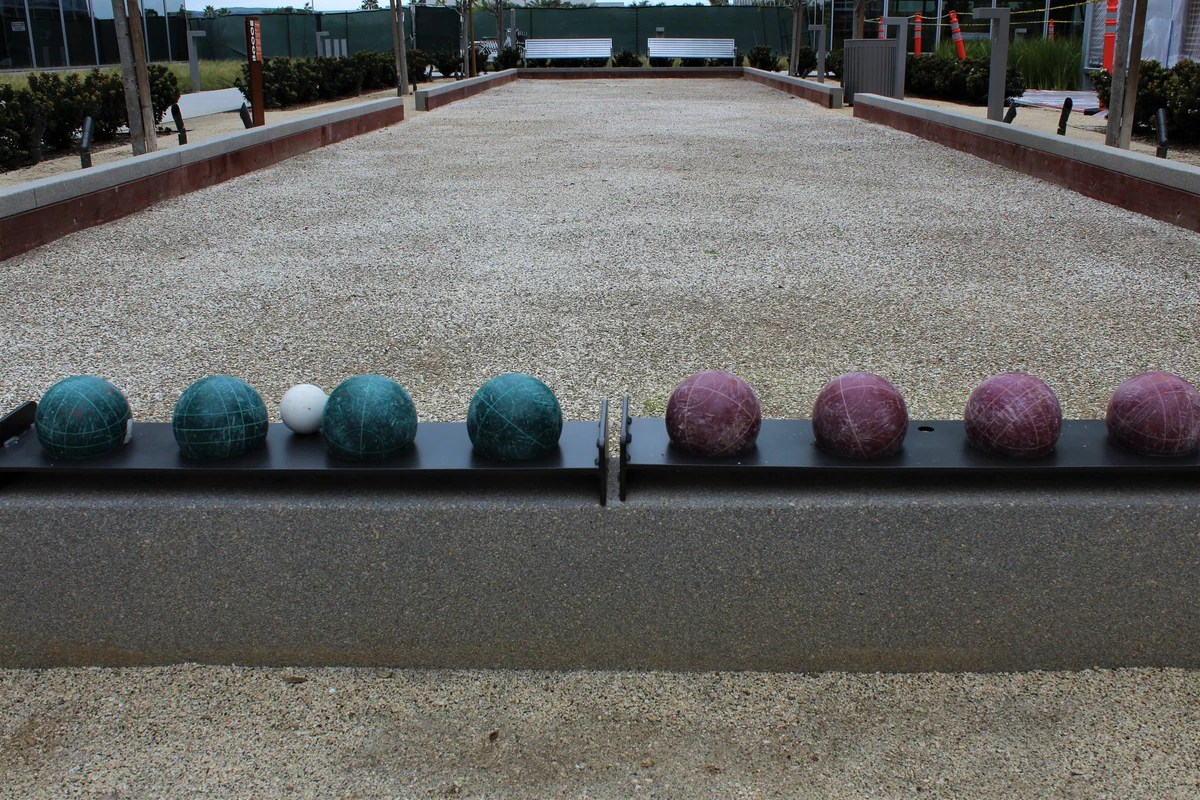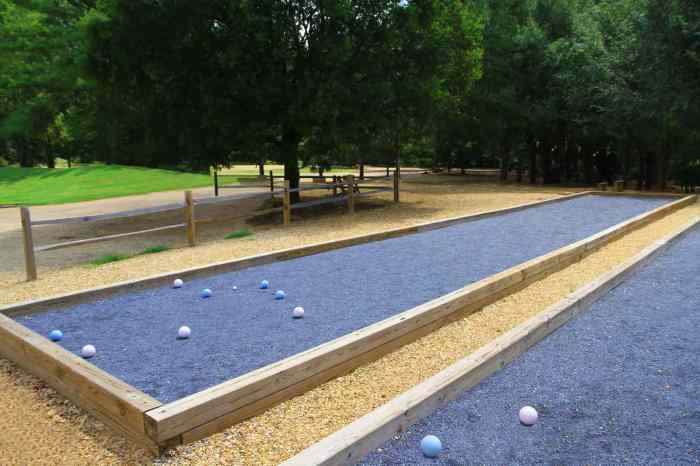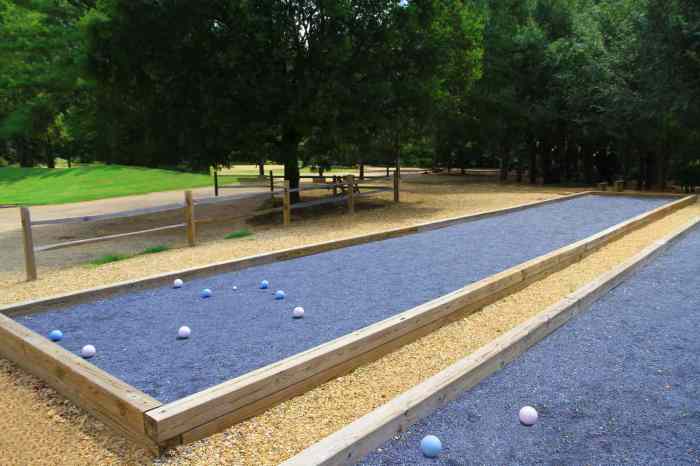DIY Bocce Ball Court sets the stage for this enthralling narrative, offering readers a glimpse into a story that is rich in detail and brimming with originality from the outset.
Imagine a sunny afternoon, the gentle clink of bocce balls, and the laughter of friends and family. This is the dream that a DIY bocce ball court can bring to life. Building your own court is not just a fun project, it’s a way to create a unique space for relaxation and entertainment right in your backyard. This guide will take you through every step, from choosing the perfect location to adding decorative touches, so you can create a bocce ball haven that you’ll enjoy for years to come.
Bocce Ball Court: A DIY Guide

Bocce ball is a popular lawn game that can be enjoyed by people of all ages and skill levels. It’s a social game that encourages friendly competition and laughter, making it a great choice for family gatherings, backyard parties, or simply relaxing evenings with friends. Building your own bocce ball court offers a unique opportunity to personalize your outdoor space and create a dedicated area for fun and entertainment.
Building a DIY bocce ball court is a rewarding project that allows you to customize the court to your specific needs and preferences. You can choose the size, materials, and design to perfectly complement your backyard and lifestyle. This article will guide you through the process of building your own bocce ball court, from planning to construction.
Target Audience
This article is designed for anyone who is interested in building their own bocce ball court. Whether you are a seasoned DIY enthusiast or a beginner, this guide will provide you with the necessary information and instructions to complete the project successfully. This guide will help you understand the basics of bocce ball court construction, including materials, tools, and techniques. We’ll also discuss important factors to consider, such as location, size, and surface.
Choosing the Right Location

The location of your bocce ball court is crucial for a successful and enjoyable experience. Several factors come into play when choosing the perfect spot, ensuring both practicality and aesthetics.
The first step is to assess your available space and its suitability for a bocce ball court. Consider the dimensions of the court, the surrounding environment, and potential obstacles.
Space Requirements
Bocce ball courts typically measure 75 feet long and 12 feet wide. This measurement accommodates a regulation-sized court with ample space for players to move around and retrieve balls. However, you can adjust these dimensions to fit your available space. For example, a shorter court might be suitable for a smaller backyard.
Sunlight Exposure
Sunlight exposure is another important factor to consider. Direct sunlight can make the court surface too hot to play on, especially during summer. Ideally, choose a location that receives partial shade during the hottest parts of the day. This will provide a comfortable playing environment and protect the surface from excessive heat damage.
Drainage
Proper drainage is essential to prevent water accumulation on the court surface. Waterlogged soil can damage the surface and create uneven playing conditions. Choose a location with good drainage or consider installing a drainage system to ensure that water flows away from the court.
Assessing Existing Ground Conditions, Diy bocce ball court
Once you have chosen a potential location, you need to assess the existing ground conditions. This involves determining the soil type, slope, and presence of any obstacles.
Soil Type
The type of soil is a critical factor in determining the suitability of the location. Sandy soil is ideal for bocce ball courts as it drains well and provides a stable playing surface. Clay soil, on the other hand, tends to be more compact and can retain water, making it unsuitable for a bocce ball court.
Slope
A level playing surface is crucial for a fair and enjoyable game. A slight slope can affect the ball’s trajectory and make it difficult to play accurately. It is recommended to choose a location with minimal slope or to level the ground before constructing the court.
Obstacles
Obstacles such as trees, rocks, or fences can interfere with play and create hazards. Choose a location free of obstacles or consider removing them before constructing the court.
Materials and Tools: Diy Bocce Ball Court
Creating a bocce ball court involves gathering the right materials and tools to ensure a smooth and successful construction process. The materials and tools will vary depending on the size and design of your court, but this guide will provide a comprehensive list to help you get started.
Materials
The materials needed for a bocce ball court can be categorized into three main groups: playing surface, drainage layer, and edging materials.
- Playing Surface: This is the most important part of the court, as it determines the playability and the overall experience.
- Sand: The most common material for the playing surface, sand provides a smooth and consistent surface for the bocce balls to roll on. It’s readily available and affordable. Use playground sand, which is fine-grained and doesn’t contain large particles or debris.
- Alternatives: While sand is the preferred choice, you can consider using crushed gravel or decomposed granite for a more durable surface.
- Sand: The most common material for the playing surface, sand provides a smooth and consistent surface for the bocce balls to roll on. It’s readily available and affordable. Use playground sand, which is fine-grained and doesn’t contain large particles or debris.
- Drainage Layer: This layer helps prevent water from pooling on the playing surface, which can make the court muddy and unplayable.
- Gravel: A layer of gravel beneath the sand provides excellent drainage, allowing water to seep through quickly.
- Alternatives: You can use crushed stone or pea gravel for the drainage layer, but ensure they are well-compacted for effective drainage.
- Gravel: A layer of gravel beneath the sand provides excellent drainage, allowing water to seep through quickly.
- Edging Materials: These materials define the boundaries of the court and prevent the playing surface from spreading.
- Concrete edging: Provides a durable and long-lasting border for the court.
- Alternatives: You can use landscape timbers, pavers, or even bricks for edging.
- Concrete edging: Provides a durable and long-lasting border for the court.
Tools
Having the right tools will make the construction process much easier and more efficient.
- Shovels: For digging, moving, and spreading materials.
- Rakes: For leveling the sand and gravel.
- Tampers: For compacting the gravel and sand layers.
- Level: For ensuring that the court is level and smooth.
- Measuring tape: For accurate measurements of the court dimensions.
- String line: For marking out the court boundaries.
- Wheelbarrow: For transporting materials around the construction site.
Material Quantities
The following table provides recommended quantities of materials based on a standard 12′ x 60′ bocce ball court:
| Material | Quantity (for a 12′ x 60′ court) | Purpose |
|---|---|---|
| Sand | 1 cubic yard | Playing surface |
| Gravel | 1/2 cubic yard | Drainage layer |
| Edging material | 60 linear feet | Define the court boundaries |
Building the Court
Now that you’ve chosen the perfect spot and gathered your materials, it’s time to bring your bocce ball court to life! This section will guide you through the construction process, step-by-step.
Site Preparation
Before you start laying down any gravel, you need to ensure a solid foundation.
- Clear the Area: Remove any existing vegetation, debris, or rocks from the chosen area. You want a clean, level surface to work with.
- Level the Ground: Use a rake and a level to create a flat, even surface. If you have significant unevenness, you may need to bring in topsoil or fill to adjust the height.
- Compact the Soil: Use a tamper or a heavy roller to compact the soil. This will help prevent settling and ensure a stable base for your court.
Laying the Gravel Base
The gravel base provides drainage and stability for your bocce ball court.
- Determine Gravel Depth: The recommended depth for a bocce ball court gravel base is 4-6 inches. This will ensure proper drainage and a stable surface for playing.
- Spread the Gravel: Spread the gravel evenly over the prepared area. Use a rake or a shovel to ensure an even distribution.
- Compact the Gravel: Use a tamper or a heavy roller to compact the gravel. This will help create a firm and stable base for your court.
Installing the Edging
Edging defines the perimeter of your court and keeps the gravel from spreading.
- Choose Your Edging: You have several options for edging, including wood, concrete, or plastic. Consider the look you want and the durability needed for your court.
- Install the Edging: Follow the manufacturer’s instructions for installing your chosen edging. Make sure it’s level and secure, creating a clean and defined boundary for your court.
Adding the Sand
The final layer of sand provides a smooth and consistent playing surface.
- Choose the Right Sand: Use a fine-grained, playground-type sand for your bocce ball court. Avoid using sand with sharp edges or large particles.
- Spread the Sand: Spread a layer of sand over the gravel base, ensuring it reaches the top of the edging. You’ll need about 2-3 inches of sand for a standard bocce ball court.
- Level the Sand: Use a rake or a long, straight board to level the sand, ensuring a smooth and even surface for playing.
Designing the Court

Now that you have chosen the location and gathered your materials, it’s time to plan the design of your bocce ball court. The design will not only impact the look of your court but also the gameplay. Consider the dimensions, surface materials, and unique design elements to create a court that meets your needs and aesthetic preferences.
Court Dimensions and Layouts
The standard bocce ball court is 76 feet long and 12 feet wide. However, you can adjust the dimensions to fit your space. For example, a smaller court might be 60 feet long and 10 feet wide. You can also create a more challenging game by incorporating curves or obstacles into the court layout. Here are some common bocce court layouts:
- Standard Layout: The most common layout is a rectangular court with a center line marking the halfway point. Players stand at one end of the court and throw their bocce balls towards the pallino, which is thrown to the other end of the court.
- Horseshoe Layout: This layout involves a horseshoe-shaped court with the pallino placed at the center of the curve. This layout can add a challenge to the game as players need to navigate the curve to get their bocce balls close to the pallino.
- Obstacle Course Layout: This layout incorporates obstacles, such as small walls or ramps, into the court. This can make the game more challenging and entertaining.
Court Surface Materials
The surface material of your bocce ball court can significantly affect the game. Here are some popular options:
- Concrete: Concrete is a durable and affordable option that can withstand heavy use. It provides a smooth and consistent surface for bocce balls to roll on. However, concrete can be hot in the summer and cold in the winter.
- Pavers: Pavers are a versatile option that can be arranged in various patterns. They offer a good balance of durability and aesthetics. Choose pavers that are flat and smooth to ensure consistent bocce ball movement.
- Grass: Grass is a natural and aesthetically pleasing option that can be used for a bocce ball court. However, it requires regular maintenance, including mowing and watering. It also provides a less predictable surface for bocce ball movement.
Unique Design Elements
Adding unique design elements can enhance the aesthetics and functionality of your bocce ball court. Here are some ideas:
- Decorative Edging: Use brick, stone, or wood to create a decorative border around the court. This can define the playing area and add visual interest.
- Landscaping Features: Incorporate landscaping features, such as trees, shrubs, or flowers, around the court. These features can provide shade and enhance the overall look of the space.
- Lighting: Install lighting fixtures around the court to allow for evening play. Consider using solar-powered lights for an eco-friendly option.
- Seating: Provide comfortable seating for spectators or players taking a break. Consider benches, chairs, or even a small patio set.
Building a DIY bocce ball court is a rewarding project that can transform your backyard into a fun-filled gathering spot. From the initial planning to the final touches, the journey itself is as enjoyable as the final result. So, gather your tools, embrace your creativity, and get ready to roll! Your own personal bocce ball haven awaits.
Building a DIY bocce ball court can be a fun and rewarding project, but it’s important to remember that certain chemicals can be harmful to the environment. For example, vincristine , a chemotherapy drug, can be toxic to plants and animals. If you’re planning on using any chemicals on your court, make sure to research their safety and environmental impact before applying them.
This will help ensure your bocce ball court is both enjoyable and sustainable.

